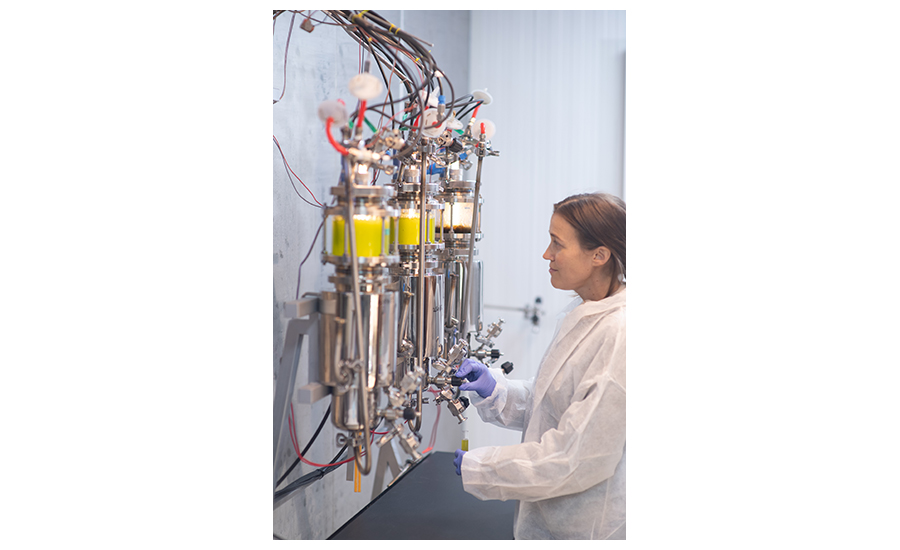Microalgae — the new alt protein?
Israel-based Brevel is working on microalgae protein that could help change the plant-based industry
,-YONATAN-GOLAN-(CEO),-MATAN-GOLAN-(COO).webp?t=1657043621)
Left to-Right: Brevel founders and brothers Ido Golan (CTO), Yonatan Golan (CEO) and Matan Golan (COO). Photos courtesy of Brevel
Founded in 2017, Israel-based Brevel is launching microalgae-based alternative protein, which is flavor and color neutral, highly functional, sustainable and at consistent and scalable production, as well as affordable.
Brevel uses non-GMO microalgae grown in a breakthrough technology that enables the highest quality of sustainable protein production at cost levels comparable to pea and soy proteins. The technology combines sugar-based fermentation of microalgae with a high concentration of light at industrial scales. The result is a protein that will be price competitive with pea and soy and is color and flavor neutral.
The company has received $8.4M in funding to date, which will go toward building a commercial pilot factory and serve as the basis for scaling Brevel’s proprietary technology and enhancing R&D capabilities.
Who is Brevel?
The company is owned by three brothers: COO Matan Golan, a flexitarian MD who brings the health angle; The second, CTO Ido Golan, an engineer with a vast background in microalgae who invented a new way of producing microalgae efficiently and at high quality; and the CEO, Yonatan Golan, a physicist who is vegan.
Yonatan is enthusiastic about finding solutions for how to feed our growing population in a sustainable and ethical way. “As a physicist, I view this challenge very rationally and believe, like many experts and companies, that microalgae can become the ultimate solution. However, to date no one has been able to solve the cost and quality barriers to make this vision become a reality,” he explains.

Today, microalgae are produced either by photosynthesis in outdoor (or indoor) ponds or closed reactors which are very labor intensive, suffer from contaminations and produce at low yields and high costs, Yonatan says. “The alternative is to use fermentation tanks where sugar is added to the process, and then the microalgae grow and significantly lower costs and higher yields. The process is done in the dark, and in the absence of light many of the ingredients, functionalities and benefits of microalgae are lost in the process. We use freely available microalgae strains and don’t do any genetic modification. We currently work with three different strains that are approved for human consumption and that grow extremely well in the conditions our technology provides.
“Compared to soy,” Yonatan continues, “the leading plant-based protein, microalgae are 99.95% more efficient in terms of land, 67% more efficient in GHG emissions and 55% more efficient in water usage.” Microalgae in the Brevel system doesn’t need pesticides, herbicides, or chemical runaways.
Cost
The biggest challenge the company faces is bridging the gap to cost parity with pea and soy. “Having an excellent product in terms of flavor, color and functionality is great, but if we cannot provide it at cost levels of the current leading protein sources, we will remain a niche protein source and won’t be able to address the global challenges of sustainable nutrition,” explains Yonatan.
The path to cost parity goes through being able to extract and valorize each of the different fractions of the microalgae independently. Yonatan said they already have developments with the oil fraction and the pigments, and are working on additional ingredients that can be produced. “This is where having light alongside sugar-based fermentation is a game changer,” he adds.
Flavor, Color, Texture
Microalgae protein comes as a dry powder that can be added directly to formulations. It can be added directly as powder, or with applying processes such as homogenization or secondary fermentation to increase its solubility, extract additional flavors and more.
“The original texture of microalgae is liquid. Our process separates the microalgae from the liquid, dries it and grounds it into powder, which is used by our partners to be inserted into food as the protein source,” Yonatan says.
In terms of functionality, he says that Brevel tries to be as inert as possible by increasing the nutritional profile of products without changing taste, color, texture or cost for the end consumer. Current sources such as pea and soy are not applicable due to their strong flavors, allergens and market perception. For meat alternatives, this isn’t a challenge because flavors can be easily masked by spices.
In the second stage, the company plans to provide functionalities such as gelation, texturing, emulsification and more, which are mostly suitable for fish and seafood alternatives.
Looking for a reprint of this article?
From high-res PDFs to custom plaques, order your copy today!







